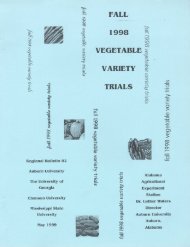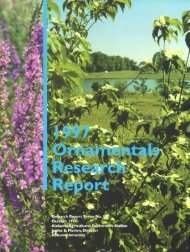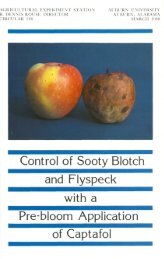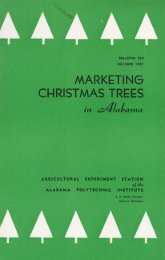Fall - Auburn University Repository
Fall - Auburn University Repository
Fall - Auburn University Repository
Create successful ePaper yourself
Turn your PDF publications into a flip-book with our unique Google optimized e-Paper software.
JANUARY FEBRUARY MARCH APRIL<br />
SMTWT F S SMT WT F S SMTWT F S SMTWT F S<br />
S2 3 4 5 6 7<br />
8 91011121314<br />
1516171819 20 21<br />
22 232425 26 27 28<br />
293031<br />
5 '<br />
' 2 3 4<br />
'0l<br />
q<br />
2 3 4 5 6 7 8<br />
91011 12 13 14 15<br />
1617 1819202122<br />
24 25 26 27 28 29<br />
MAY<br />
SMTWY<br />
123<br />
1 2 3<br />
7 8 9 101<br />
14 15 16 17 I<br />
21 2223242<br />
28293031<br />
Timely Planting<br />
Ups Oat Yields<br />
SEPTEMBER<br />
SMTWT F S<br />
12 I 4<br />
3 4 5 6 7 8 9 8 9,0 , 101<br />
10 11 12 13 14 15 16 15 16 17 18 iv ... . 15 16 17 18<br />
17 18 192021 22 23 22 23 24 25 26 27 28 1920 21 22 23 24 25<br />
24 25 26 27 28 29 30 293031, 2627282930<br />
F. S. McCAIN and C. C. KING, Dept. of Agronomy and Soils<br />
P LANTING OATS at the right time can<br />
put more dollars in your pocket. Research<br />
results show that yields of oats<br />
can be increased by planting earlier<br />
than is the usual practice.<br />
Experiments on dates of planting oats<br />
were conducted during 1952-57 by the<br />
<strong>Auburn</strong> <strong>University</strong> Agricultural Experiment<br />
Station. The tests at seven locations<br />
were designed to measure effect<br />
of date of planting on yields of oats<br />
grown for grain only and for forage and<br />
grain combined.<br />
Two Management Systems Tested<br />
Oats were seeded at the rate of 3 bu.<br />
per acre. Two series of plots were used<br />
at each location with one series managed<br />
for grain production only. These plots<br />
received adequate rates of phosphate<br />
and potash fertilizers at planting. Fifty<br />
lb. of nitrogen was applied as a topdressing<br />
about March 1.<br />
Another series of plots was managed<br />
AUGUST<br />
-WT F S<br />
2345<br />
1 2 3 4 5<br />
1 91011 12<br />
16 17 18 19<br />
223242526<br />
.9 3031<br />
DECEMBER<br />
SMTWT F S<br />
12<br />
3456789<br />
3 4 5 6 7 8 9<br />
10 11 12 13 14 15 16<br />
17 18 192021 2223<br />
2425 26 27 28 29 30<br />
31<br />
for production of forage (grazing) and<br />
grain. These plots received the same<br />
phosphate and potash fertilization at<br />
planting as those managed for grain<br />
only. In addition, a topdressing of 50<br />
lb. of nitrogen per acre was applied<br />
when oats were up to a stand. Forage<br />
removal was discontinued about March<br />
1 and an additional 50 lb. of nitrogen<br />
per acre was applied. All. plots in both<br />
series were allowed to mature a crop of<br />
grain and grain yields were measured.<br />
When consumed as green pasturage,<br />
1 lb. of dry matter from oat forage is<br />
considered equal in feed value to 1 lb.<br />
of oat grain. This factor was used to<br />
convert forage yields to grain equivalents<br />
in measuring yields.<br />
As shown in Figure 1, forage yields<br />
for comparable dates were highest in<br />
southern Alabama. There was little difference<br />
in forage yields for comparable<br />
dates between central and northern<br />
areas of the State. Highest grain yields<br />
SNorthern Central Southern Northern Central Southern<br />
FIG. 1. Yields of oat forage from different<br />
planting dates during the 1952-57 test<br />
years are shown by the graph above.<br />
12<br />
FIG. 2. Shown above is a comparison of<br />
grain yields from clipped oats from different<br />
planting dates during 1952-57.<br />
on clipped plots for all planting dates<br />
were produced in northern Alabama,<br />
followed in order by central and southern<br />
regions, Figure 2.<br />
A comparison of Figures 2 and 4<br />
shows that yields of grain were decreased<br />
by clipping, but the forage obtained<br />
more than compensated for the loss.<br />
When forage and grain yields were combined,<br />
there was little difference in maximum<br />
per acre production of feed in<br />
all regions, Figure 8. However, there<br />
was a difference in the best date to plant<br />
for maximum yields.<br />
Best Planting Dates<br />
Recommended planting dates for forage<br />
and grain production in the three<br />
regions are: northern Alabama, September<br />
1 to September 20; central Alabama,<br />
September 1 to September 30;<br />
and southern Alabama, September 20 to<br />
October 20. Planting dates did not materially<br />
affect yield of oats grown for<br />
grain only in any of the regions, Figure<br />
4. The maximum difference, 8 bu. per<br />
acre, occurred between the September<br />
10 and October 20 planting dates in<br />
central Alabama. This indicates that<br />
most any of the planting dates in any of<br />
the State's regions is satisfactory for<br />
grain production only.<br />
Yield,<br />
pounds per acre<br />
3,20 0<br />
1400<br />
S Forage and grain<br />
Grain only<br />
FIG. 3. Combined yields of forage and<br />
grain from oats planted at different dates<br />
during 1952-57 are shown in the graph.<br />
Aug. Sept Sept Oct Aug. Sept Sept Oct.N S S pO ct.00 6.<br />
20 130020 20 10320 10 103020 10<br />
Northern Central Southern<br />
FIG. 4. Shown here are yields of oats managed<br />
for grain only from different planting<br />
dates in 1952-57 experiments.
















